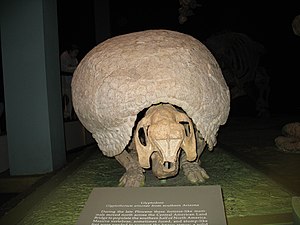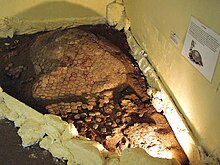Glyptotherium
| Glyptotherium | ||||||||||||
|---|---|---|---|---|---|---|---|---|---|---|---|---|

Skeleton of Glyptotherium arizonae |
||||||||||||
| Temporal occurrence | ||||||||||||
| Upper Pliocene to Upper Pleistocene | ||||||||||||
| 1.8 million years to 12,000 years | ||||||||||||
| Locations | ||||||||||||
|
||||||||||||
| Systematics | ||||||||||||
|
||||||||||||
| Scientific name | ||||||||||||
| Glyptotherium | ||||||||||||
| Osborn , 1903 | ||||||||||||
Glyptotherium ( Greek "carved animal") is a genus of extinct mammals related to the armadillos . It belongs as the known, similar genre Glyptodon from South America into the group of glyptodontidae and is therefore sometimes referred to as "North American Glyptodon " means.
features
Like today's armadillos, the glyptodons had armor, which, however, covered the entire body of the animal, similar to a turtle shell . The carapace of Glyptotherium consisted of hundreds of small, square or hexagonal plates, which restricted the mobility of the hull through their close connection. An adult Glyptotherium reached a length of 180 centimeters.
The typical hexagonal plates of the armor were patterned from a central and several surrounding fields, which are used to differentiate the species. A distinction is made between the following types:
- Glyptotherium arizonae - flat central pattern of armor plates, maximum 50% of the area
- Glyptotherium cylindricum - flat central pattern of armor plates, maximum 50% of the area, from Mexico
- Glyptotherium floridanum - central pattern about the same size as the peripheral, slightly concave, Mexico to Florida
- Glyptotherium mexicanum - large central specimen, from Mexico
- Glyptotherium texanum - large convex, raised central pattern, found in Florida , South Carolina and Texas
distribution
Glyptotheria lived in the tropical and subtropical regions of North America, from Mexico to the Gulf States of the United States to Oklahoma . The extinction of the genus is likely due to climatic changes at the end of the Ice Age or to human action . However, there is no direct evidence that it was actually hunted by humans. The most recent fossil finds of Glyptotherium texanum date from around 12,000 years ago, i.e. from the Upper Pleistocene .
literature
- Jim I. Mead, Sandra L. Swift, Richard S. White, H. Greg McDonald, Arturo Baez: Late Pleistocene (Rancholabrean) Glyptodont and Pampathere (Xenarthra, Cingulata) from Sonora, Mexico . In: Revista Mexicana de Ciencias Geológicas . tape 24 , no. 3 , 2007, ISSN 0185-0962 , p. 439–449 ( thewildlifemuseum.org [PDF; 500 kB ]).
Web links
- AMNH Bestiary. Retrieved June 18, 2006 .

